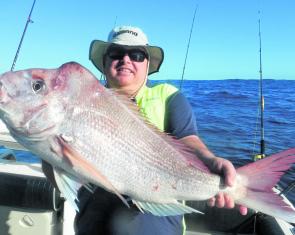The transition from summer species to winter species is well and truly complete by August, however there were a few surprises up to July as the pelagics lingered prior to heading north in search of warmer water.
Scattered schools of northern bluefin tuna, and occasional lone fish terrorising bait anglers continue to turn up, most unexpectedly. Big mobs of fat tuna have been seen harassing baitfish very close to the rocks along the National Park, often within casting distance. These fish move often but are definitely a viable target from the shoreline, if you are prepared. A medium to heavy spin stick loaded with 20-30lb braid, a quality leader in the 40lb class and a shiny slug with a strong hook attached will do the job. Any less and an empty spool will be the result.
I encountered a quality fish with some mates out at Sunshine Reef recently. A live yakka was deployed behind the boat in the berley trail while we concentrated on pulling up reef fish. Once the baitrunner started to sing it only took one turn of the handle to set the hooks. The ensuing battle lasted 15 to 20 minutes, culminating with the fish circling a metre or so from the surface. This is pretty standard tuna practice, and Dwyane Cook at Davo’s Compleat Angler pointed out that they always circle anti-clockwise! Very interesting…
Anyway, the tuna was circling around the anchor rope, so the battle was getting a tad hairy so to speak. Eight or ten wraps of 30lb braid around the anchor rope clearly was not a good position to be in with 20kg of tuna still circling below us. Skipper Lance McFayden was up to the task though and lifted the hefty fish aboard after a very neat gaff shot.
Snapper have been very evident on catch lists of late. It seems that the early part of the cooler months have seen quality snapper in close and out wide of Chardons Reef, with not much to brag about in between. Some crews cleaned up while others did it tough. Several moves were sometimes required to find the fish, and boats that did bagged out on fish from 4-8kg.
The run up to Double Island Point has been most worthwhile for the bigger boats. Peter Wells and his mate Mark Ziersch made the effort recently in Pete’s 7.3m Markham Dominator. The boys had a ball catching big snapper, pearl perch, cobia and a host of other species. In good conditions it only takes an hour or so from the Noosa bar and the rewards often make the trip very worthwhile.
By August we should have plenty of snapper on the local reefs. Snell rigs with pilchard or squid baits are a good way to get a feed of tasty snapper. Just enough lead to hold near the bottom will do the job nicely. Floating a whole pilchard down the berley trail will also bring snapper on board and other species too.
The Noosa River has been firing well to date. Hordes of trevally and some quality tailor have been hunting in the Woods Bay region. Dawn and dusk sessions are the go with Gladiator Prawns, poppers and slugs very effective tools of choice.
The river mouth has had very large numbers of bream available. Small chunks of pilchard, or any fish flesh, will keep the kids interested with bites galore and plenty of fish coming over the gunwale. Quality whiting too have been targeted in the lower reaches with the Frying Pan a great place to start. Live worms are hard to beat if you want a feed of tasty whiting fillets.
Flathead are also present in big numbers with Weyba Creek well worth a shot. Wading and casting plastics into the deeper pools is producing well, with pink the colour of choice. Drifting with small pilchards or hardiheads on small gangs is also a very effective way to chase flathead. Fish the run-out tide for best results.
The mud crabs will be thinning out considerably by now, but there have been a few quality bucks potted near the ferry crossing. It is always worthwhile throwing a pot of two in, to be collected at the end of the day. Be wary of sharefarmers.
Reads: 1864
Mark Ziersch made the effort to head up the coast to Double Island Point. It was well worthwhile.

A most respectable northern bluefin tuna that scoffed a live yakka at Sunshine Reef.

This golden trevally caught by Brad McLean took a liking to a River2Sea bibbed minnow.




